
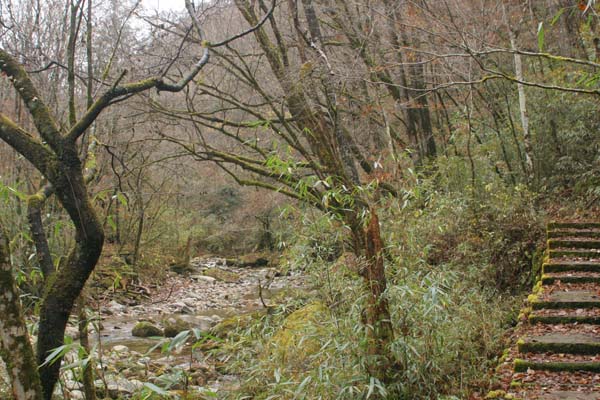 Foping Nature Reserve
protects 86,000 acres of pristine oak-conifer forest in the Qinling
Mountains, in the center of China, whose ravines and valleys are choked
with bamboo. This is in wild and remote country and is one of the best
locales for a population of Giant Panda.
Foping Nature Reserve
protects 86,000 acres of pristine oak-conifer forest in the Qinling
Mountains, in the center of China, whose ravines and valleys are choked
with bamboo. This is in wild and remote country and is one of the best
locales for a population of Giant Panda.
Our bus dropped us off at the saddle at 6850' (2090m) where the road ends and a huge portal announces the Reserve with a view termed "the eyes of the panda" (below). By the time we climbed back up to this spot five days later, it had snowed at this elevation and there was still snow on the ground (see photo below).
It is a 5-mile hike from the saddle down to the Sanguanmiao Research Station. The entire hike is on a concrete path (far right), much of it along a stream, with hundreds of steps.

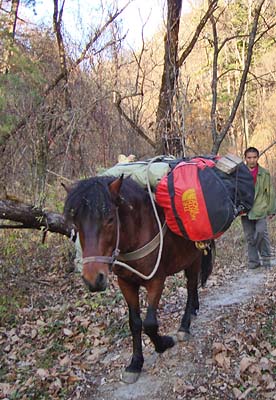 All
supplies are brought in by ponies, and our suitcases and food were sent
down that way (left). The Research Station is set at 5000' elev
(1515m), surrounded by fall colors (full-width photo below). It is
serviced by a small hydroelectric plant, so there is 24-hour
electricity and running water, but in mid-November, the time of our
visit, the streams were low and therefore power and water pressure were
uncertain. For reasons never explained, the Research Station is not
heated. Nighttime temperatures drop to near-freezing, making for very
cold nights, even indoors. The buildings themselves, including the
two-story blockhouse in which we stayed, are concrete. The guides,
interpreters, and researchers typically wear camouflage gear, giving
the entire site the feeling of a military compound (just below).
All
supplies are brought in by ponies, and our suitcases and food were sent
down that way (left). The Research Station is set at 5000' elev
(1515m), surrounded by fall colors (full-width photo below). It is
serviced by a small hydroelectric plant, so there is 24-hour
electricity and running water, but in mid-November, the time of our
visit, the streams were low and therefore power and water pressure were
uncertain. For reasons never explained, the Research Station is not
heated. Nighttime temperatures drop to near-freezing, making for very
cold nights, even indoors. The buildings themselves, including the
two-story blockhouse in which we stayed, are concrete. The guides,
interpreters, and researchers typically wear camouflage gear, giving
the entire site the feeling of a military compound (just below).

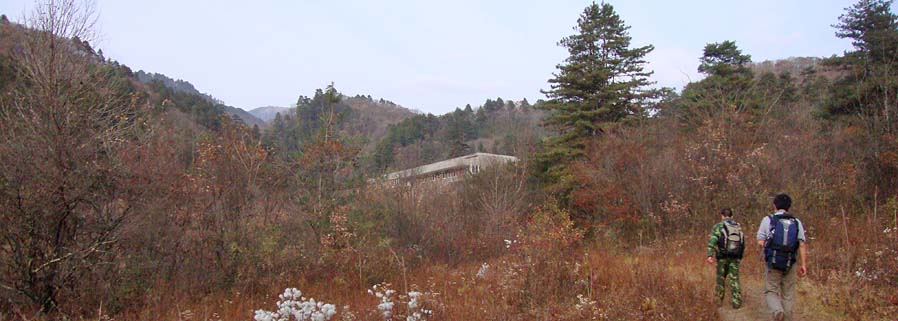

We were up early every day, as the mist lifted from the surrounding hills (right), and we set out with trackers to search for signs of panda. Panda 'poo' was easy to find in bamboo thickets. Pandas spend much of each day eating bamboo. It is low in nutrition so they must eat a lot of it daily to survive. Most of it is excreted as potato-sized green droppings (below left).
While the trackers were out searching for a panda, we were often asked to sit and wait in a spot, sometimes for hours at a time (below right). Most days were a combination of strenuous hikes and long waits, occasionally interrupted by a flock of babblers, parrotbills, and woodpeckers.
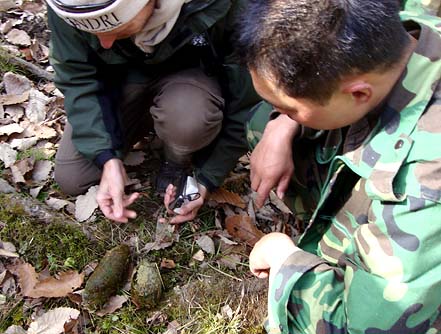 |
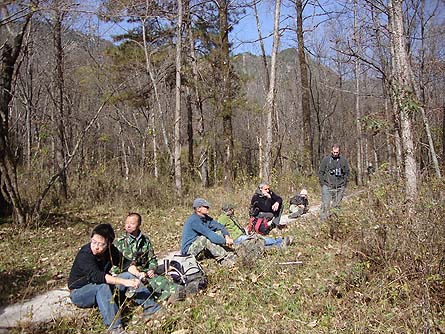 |
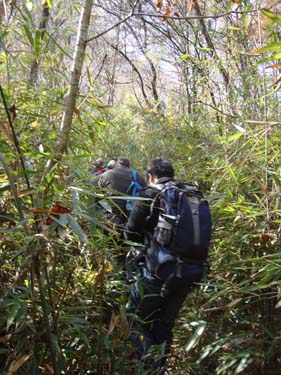 When
the trackers radio to the interpreters that they've found a panda — as
they did on days #2 and #3 of our five day stay — the group is led on a
desperate climb up a ravine, through thick bamboo (right), or
scrambling up a rocky stream, to try to reach the panda site before the
beast is spooked and runs away. Communications between trackers and our
group was often confused, and each time a panda was found, it ended up
running away, crashing through the bamboo.
When
the trackers radio to the interpreters that they've found a panda — as
they did on days #2 and #3 of our five day stay — the group is led on a
desperate climb up a ravine, through thick bamboo (right), or
scrambling up a rocky stream, to try to reach the panda site before the
beast is spooked and runs away. Communications between trackers and our
group was often confused, and each time a panda was found, it ended up
running away, crashing through the bamboo.
If you were very physically fit, some could sometimes 'cut off' the bear from a viewpoint and see it — I never was fast enough or fit enough to do so. Must saw their panda by clambering up a very steep ridge in time to see a panda running uphill past them that the trackers had 'pushed' in the group's direction by circling below and behind. I saw just a lot of bamboo thickets (below left) and some lovely waterfalls (below right), but no bear.
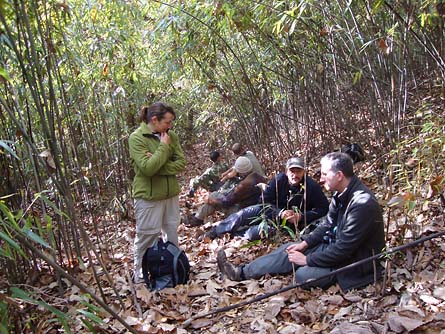 |
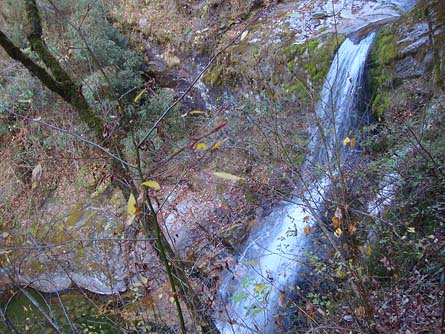 |
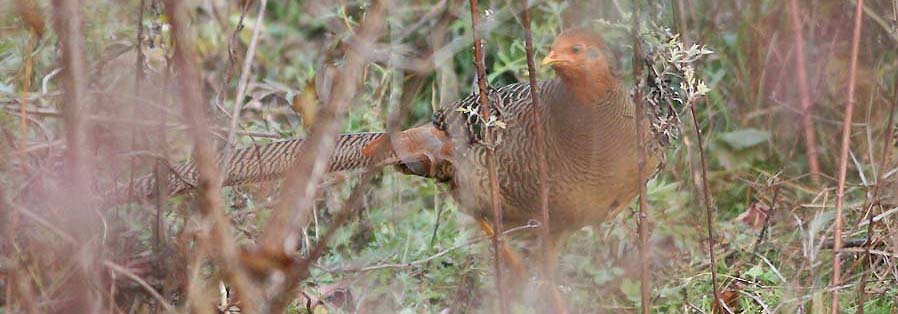
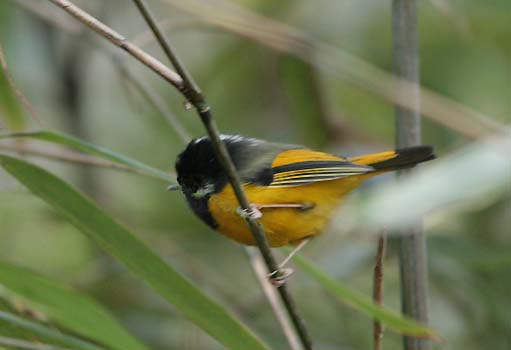 I did see, however, some spectacular birds. Golden Pheasant
was a common species (up to 50/day) but very shy and skittish. My best
shot, partially obscured, was of a young male (above). I was only able
to digiscope the gorgeous adult male at long range (just below).
I did see, however, some spectacular birds. Golden Pheasant
was a common species (up to 50/day) but very shy and skittish. My best
shot, partially obscured, was of a young male (above). I was only able
to digiscope the gorgeous adult male at long range (just below).
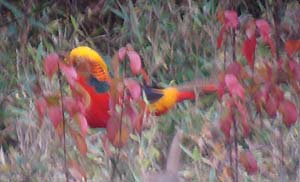
Golden-breasted Fulvetta (right) was found daily in small and very active flocks that would briefly appear and then vanish.
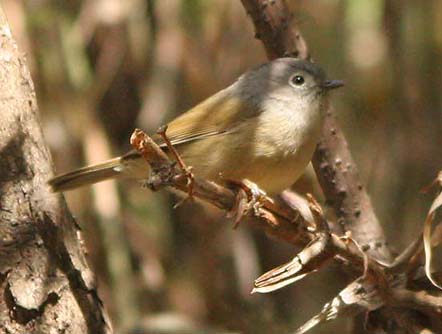 |
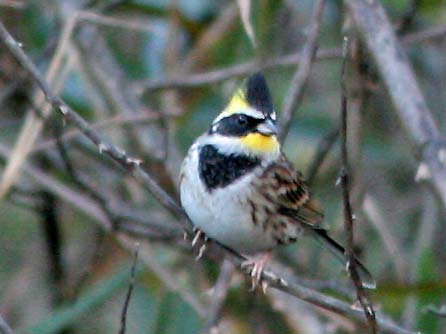 |
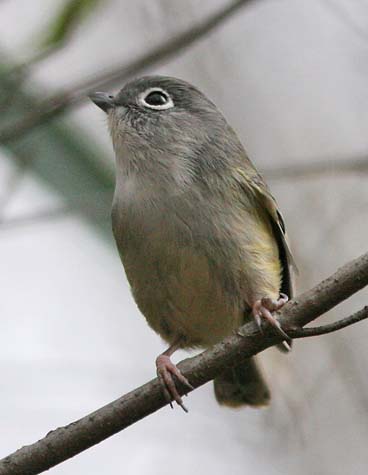 What we called "Gray-cheeked Fulvetta Alcippe morrisonia"
(above left) was a common component of mixed species flocks in bamboo.
I've since learned that new research has split this taxa into four
separate species. The nominate A. morrisonia is now restricted to Taiwan; our bird was David's Fulvetta A. davidi
(above left). With the split-up of the traditional babbler family
Timaliidae into five families, it is now part of the Pellorneidae [see
my page on that new Family].
What we called "Gray-cheeked Fulvetta Alcippe morrisonia"
(above left) was a common component of mixed species flocks in bamboo.
I've since learned that new research has split this taxa into four
separate species. The nominate A. morrisonia is now restricted to Taiwan; our bird was David's Fulvetta A. davidi
(above left). With the split-up of the traditional babbler family
Timaliidae into five families, it is now part of the Pellorneidae [see
my page on that new Family].
A Yellow-throated Bunting (above right) appeared right outside our lodging one morning. Several times we had mixed flocks whose leader was Green Shrike-Babbler (right). The shrike-babblers [genus Pteruthius] are particularly interesting because recent genetic work has shown they are not even remotely related to babblers — instead, they are related to New World vireos! Most up-to-date family lists now place them among the Vireonidae [e.g., IOC list] but they diverged from vireos about 30 million years ago. I have tentatively placed them in their own family [Pteruthiusidae] in my 10th edition list of Bird Families of the World, consistent with other groups that diverged that long ago and which are universally considered Family level.
Another common member of mixed species flocks was Gray-capped Woodpecker (below left). I was particularly interested in the vocal and elusive laughingthrushes, which are now placed in family Leiothrichidae. I managed only a single shot of Moustached Laughingthrush (below right) during my stay, but Chinese Babax and Barred Laughingthrush were also seen. The latter was viewed when Jono Roussouw and I crawled deep inside a bamboo thicket and Jono 'pished' a pair in close.
 |
 |
Birds at Foping Nature Reserve — recorded by me 11–15 Nov 2010 [others had additional species] Mountain Hawk-Eagle Nisaetus nipalensis |
Continue to pages on . . . |
|
Return to Introduction page |
|
page created 18 Dec 2010
|
© Don Roberson 2010 |